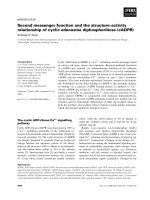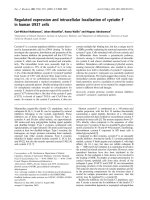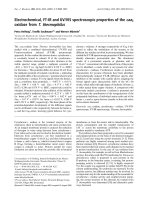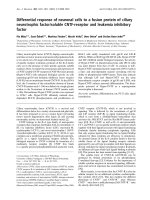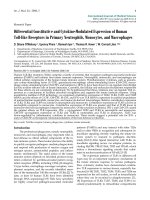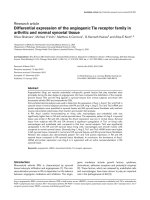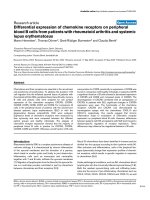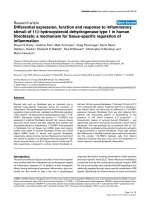Báo cáo y học: "Differential expression, function and response to inflammatory stimuli of 11β-hydroxysteroid dehydrogenase type 1 in human fibroblasts: a mechanism for tissue-specific regulation of inflammation" pps
Bạn đang xem bản rút gọn của tài liệu. Xem và tải ngay bản đầy đủ của tài liệu tại đây (797.69 KB, 10 trang )
Open Access
Available online />Page 1 of 10
(page number not for citation purposes)
Vol 8 No 4
Research article
Differential expression, function and response to inflammatory
stimuli of 11β-hydroxysteroid dehydrogenase type 1 in human
fibroblasts: a mechanism for tissue-specific regulation of
inflammation
Rowan S Hardy
1
, Andrew Filer
2
, Mark S Cooper
1
, Greg Parsonage
2
, Karim Raza
2
,
DebbieLHardie
2
, Elizabeth H Rabbitt
1
, Paul M Stewart
1
, Christopher D Buckley
2
and
Martin Hewison
3
1
Division of Medical Sciences, Institute of Biomedical Research, The University of Birmingham Medical School, Birmingham, UK
2
Division of Immunity and Infection, Institute of Biomedical Research, The University of Birmingham Medical School, Birmingham, UK
3
Division of Endocrinology, Diabetes and Metabolism, Cedars-Sinai Medical Center, Los Angeles, California, USA
Corresponding author: Martin Hewison,
Received: 7 Apr 2006 Revisions requested: 10 May 2006 Revisions received: 22 May 2006 Accepted: 19 Jun 2006 Published: 17 Jul 2006
Arthritis Research & Therapy 2006, 8:R108 (doi:10.1186/ar1993)
This article is online at: />© 2006 Hardy et al.; licensee BioMed Central Ltd.
This is an open access article distributed under the terms of the Creative Commons Attribution License ( />),
which permits unrestricted use, distribution, and reproduction in any medium, provided the original work is properly cited.
Abstract
Stromal cells such as fibroblasts play an important role in
defining tissue-specific responses during the resolution of
inflammation. We hypothesized that this involves tissue-specific
regulation of glucocorticoids, mediated via differential regulation
of the enzyme 11β-hydroxysteroid dehydrogenase type 1 (11β-
HSD1). Expression, activity and function of 11β-HSD1 was
assessed in matched fibroblasts derived from various tissues
(synovium, bone marrow and skin) obtained from patients with
rheumatoid arthritis or osteoarthritis. 11β-HSD1 was expressed
in fibroblasts from all tissues but mRNA levels and enzyme
activity were higher in synovial fibroblasts (2-fold and 13-fold
higher mRNA levels in dermal and synovial fibroblasts,
respectively, relative to bone marrow). Expression and activity of
the enzyme increased in all fibroblasts following treatment with
tumour necrosis factor-α or IL-1β (bone marrow: 8-fold and 37-
fold, respectively, compared to vehicle; dermal fibroblasts: 4-
fold and 14-fold; synovial fibroblasts: 7-fold and 31-fold; all P <
0.01 compared with vehicle). Treatment with IL-4 or interferon-γ
was without effect, and there was no difference in 11β-HSD1
expression between fibroblasts (from any site) obtained from
patients with rheumatoid arthritis or osteoarthritis. In the
presence of 100 nmol/l cortisone, IL-6 production – a
characteristic feature of synovial derived fibroblasts – was
significantly reduced in synovial but not dermal or bone marrow
fibroblasts. This was prevented by co-treatment with an 11β-
HSD inhibitor, emphasizing the potential for autocrine activation
of glucocorticoids in synovial fibroblasts. These data indicate
that differences in fibroblast-derived glucocorticoid production
(via the enzyme 11β-HSD1) between cells from distinct
anatomical locations may play a key role in the predeliction of
certain tissues to develop persistent inflammation.
Introduction
The profound effects of glucocorticoids on the immune system
have underpinned their widespread use as therapeutic agents
for inflammatory diseases [1]. In addition to their therapeutic
effects during pathological persistent inflammation, glucocor-
ticoids are also known to play a key role in physiological
responses directed at resolving inflammation at both systemic
and tissue-specific levels [2,3]. These effects are mediated at
a molecular level by the nuclear glucocorticoid receptor (GR)
[4], but recent studies have indicated that GR signalling is rhe-
ostatically regulated through tissue-specific metabolism of GR
ligands. Specifically, the interconversion of active and inactive
C/EBP = CCAAT/enhancer binding protein; Ct = the cycle number at which logarithmic PCR plots cross a calculated threshold line; ELISA = enzyme-
linked immunosorbent assay; GR = glucocorticoid receptor; 11β-HSD = 11β-hydroxysteroid dehydrogenase; H6PDH = hexose-6-phosphate dehy-
drogenase; IL= interleukin; NADPH = nicotinamide adenine dinucleotide phosphate, reduced form; OA = osteoarthritis; PCR = polymerase chain
reaction; RA = rheumatoid arthritis; SD = standard deviation; TLC = thin-layer chromatography; TNF = tumour necrosis factor.
Arthritis Research & Therapy Vol 8 No 4 Hardy et al.
Page 2 of 10
(page number not for citation purposes)
glucocorticoids is catalyzed by the enzyme 11β-hydroxyster-
oid dehydrogenase type 1 (11β-HSD1), which is located on
the luminal surface of the endoplasmic reticulum [5,6]. The
bidirectional nature of 11β-HSD1 means that it has capacity
for both reductase (that is, conversion of inactive cortisone to
active cortisol) and dehydrogenase (that is, cortisol to corti-
sone) metabolism. However, in most physiological settings the
enzyme exhibits predominant reductase activity as a conse-
quence of the coincident expression of hexose-6-phosphate
dehydrogenase (H6PDH), which facilitates enhanced, local-
ized concentration of the cofactor for 11β-HSD1, namely
NADPH (nicotinamide adenine dinucleotide phosphate,
reduced form), within the endoplasmic reticulum lumen [7].
Expression of 11β-HSD1 occurs primarily in GR-rich tissues,
where the enzyme acts to increase local levels of active gluco-
corticoids, thereby providing a system for autocrine induction
of GR-mediated responses [5,6]. Prominent among these tis-
sues is the liver, where glucocorticoids act as key metabolic
regulators [8]. However, the enzyme is also abundantly
expressed by cells such as adipocytes [9,10], osteoblasts
[11], myocytes [12,13] and vascular cells [14], suggesting an
additional role for 11β-HSD1 as a determinant of glucocorti-
coid responses in mesenchymal cells. This includes effects on
cell proliferation [15], differentiation [9,10,16] and function
[17], most notably in fat, where the enzyme appears to be a
key facet of adipocyte differentiation [13,14] and insulin sensi-
tivity [18]. The presence of 11β-HSD1 in fibroblasts was pre-
viously documented [19,20], particularly in the context of
adipocyte differentiation [21]. Analysis of 11β-HSD1 in adi-
pose stromal cells has revealed significant variations in
enzyme expression between fat depots from different locali-
ties, suggesting that the enzyme is an important factor in site-
specific responses to glucocorticoids [10,22]. However, the
underlying impact of the enzyme in terms of mesenchymal stro-
mal cell function has still to be fully defined. In studies pre-
sented here we examined site-specific expression of 11β-
HSD1 in fibroblasts and show that the resulting variations in
glucocorticoid metabolism play an important role in defining
fibroblast cell phenotype and their functional responses to
inflammation.
Materials and methods
Isolation and culture of human fibroblasts
All reagents used in cell culture were obtained from Sigma
(Poole, UK) unless otherwise stated. Fibroblasts were isolated
from biopsies of matched skin, bone marrow and synovium
removed during total knee arthroplasty [23] from consenting
patients who fulfilled the American College of Rheumatology
(formally the American Rheumatism Association) criteria for
rheumatoid arthritis (RA; n = 6) and osteoarthritis (OA; n = 3).
Fibroblasts were isolated by mechanical digestion of tissue
followed by dissociation in 5 mmol/l EDTA for 2 hours. Disso-
ciated tissue was then washed and transferred to a culture
flask. The fibroblasts were then cultured through to a maximum
of seven passages in complete fibroblast medium consisting
of RPMI-1640, 1% (vol/vol) non-essential amino acids, 1%
penicillin/streptomycin, 1% sodium pyruvate, 2 mmol/l
glutamine and 20% heat-inactivated foetal bovine serum
(Labtech International, Sussex, UK) [23]. Fibroblasts were
treated with 10 ng/ml IL-1, tumour necrosis factor (TNF)-α, IL-
4 and interferon-γ (R&D Systems, Abingdon, UK) or 100 nmol/
l cortisol or cortisone for 24 hours before harvesting.
Immunohistochemistry
Cryostat tissue sections of synovial tissue from patients with
RA were analyzed using goat polyclonal antibodies to 11β-
HSD1 (The Binding Site, Birmingham, UK) with anti-sheep/
goat biotin AB360 as secondary antibody (The Binding Site).
Immunohistochemistry was also carried using polyclonal antis-
era to the following: the endothelial marker von Willebrand
Factor (vWF; Dako, Ely, UK) with a secondary anti-rabbit
AMCA antiserum (Jackson ImmunoResearch Laboratories,
Inc., West Grove, PA, USA); the fibroblast marker ASO2
(CD90) with a secondary anti-mouse IgG
1
Alexa 633 antise-
rum (Invitrogen, Paisley, UK); and the UCHT-1 (CD3) antise-
rum (gift from Peter Beverly, UCL, London, UK) with secondary
anti-mouse IgG
2b
TRITC (Southern Biotech, Birmingham,
USA). Immunohistochemical analyses and subsequent image
visualization were carried out as described previously [24].
RNA extraction and reverse transcription
RNA was extracted from cultured fibroblasts using the single-
step extraction method (TRI Reagent, Sigma, Poole, UK). Aliq-
uots (1 µg) of RNA were then reverse transcribed using ran-
dom hexamers in a 20 µl volume, as stated in the
manufacturer's protocol (Promega, Madison, WI, USA) [25].
Real-time PCR
Expression of mRNA for 11β-HSD1, H6PDH, GRα, GRβ, IL-
6, CCAAT/enhancer binding protein (C/EBP)α and C/EBPβ
was assessed using real-time PCR in an ABI 7500 system
(Applied Biosytems, Warrington, UK). The reactions were per-
formed in 25 µl aliquots on a 96 well optical reaction plate
(Sigma). Primers for 18S were used in conjunction with our
target primers as an internal reference. Reactions contained
TaqMan universal PCR master mix (Applied Biosytems), 900
nmol primers, 100–200 nmol TaqMan probe and 25–50 ng
cDNA. Target genes probes were labelled with FAM and 18S
probes were labelled with VIC. Reactions occurred as follows:
50°C for 2 minutes, 95°C for 10 minutes, 44 cycles of 95°C
for 15 seconds and 60°C for 1 minutes. Data were obtained
as Ct values (the cycle number at which logarithmic PCR plots
cross a calculated threshold line) according to the manufac-
turer's guidelines (Applied Biosytems), and used to determine
∆Ct values (Ct of target gene - Ct of housekeeping gene) as
raw data for gene expression (high ∆Ct = low gene expres-
sion). The fold change in gene expression was determined by
subtracting ∆Ct values for treated cells from their respective
control samples. The resulting ∆∆Ct values were then used to
Available online />Page 3 of 10
(page number not for citation purposes)
calculate fold change in gene expression according to the
expression 2
∆∆Ct
. Probe and primer sequences used are sum-
marized in Table 1.
11β-Hydroxysteroid dehydrogenase enzyme assays
Confluent cells in 12-well plates were cultured with 1 ml com-
plete fibroblast medium, containing 100 nmol/l cortisone (to
measure reductase activity) or cortisol (dehydrogenase activ-
ity) along with tritiated tracer for 18 hours. Steroids were
extracted from growth medium using dichloromethane (5–10
vol) and separated by thin-layer chromatography (TLC) using
ethanol:chloroform (8:92) as the mobile phase. TLC plates
were analyzed using a Bioscan imaging detector (Bioscan,
Washington, DC, USA) and the fractional conversion of ster-
oids was calculated. In each case total protein concentration
was assessed using a 96-well plate assay kit (Bio-Rad labora-
tories Inc., Hercules, CA, USA). Results were expressed as
pmol product/hour per mg protein. All experiments were car-
ried out in triplicate.
Analysis of IL-6 and cortisol levels by ELISA
Cortisol levels in supernatants from cultured cells were meas-
ured using a commercially available sandwich ELISA in
accordance with the manufacturer's instructions (R&D sys-
tems, Abingdon, UK). Data were expressed as pg cortisol/mg
protein. Soluble IL-6 in supernatents from cultured cells was
measured using a commercially available sandwich ELISA in
accordance with the manufacturer's instructions (BD Bio-
sciences Pharmingen, San Diego, CA, USA). Data were
expressed as pg IL-6/mg protein.
Statistical analysis
Data are reported as mean ± standard deviation (SD) of repli-
cate mean values for separate patient cell cultures. However,
because of interindividual variation, data in Figures 1 and 2 are
shown as representative means (±SD) from single patient cell
cultures. In these experiments assays were repeated at least
twice using different cell preparations, with similar results.
Regression analysis was performed using Microsoft Excel
Table 1
Probes and primer sequences used
Gene Primers and probes
11β-HSD1 Forward primer: AGGAAAGCTCATGGGAGGACTAG
Reverse primer: ATGGTGAATATCATCATGAAAAAGATTC
Probe: CATGCTCATTCTCAACCACATCACCAACA
H6PDH Forward primer: CAGGTGTCCTAGTGCACATTGAC
Reverse primer: GTAGCCCACTCTCTCGTCCAA
Probe: AAGGCACGCCCTCCCAGCG
GRα Forward primer: GCGATGGTCTCAGAAACCAAAC
Reverse primer: GAGATTACAGAGGAAGTTATCCTCTGC
Probe: TGCAGTGAAGGTTGCTGAGGCTCTGA
GRβ Forward primer: AAC TGG CAG CGG TTT TAT CAA CT
Reverse primer: AACTCTTGGATTCTATGCATGAAAATGTTA TGTGGTTA
Probe: TGT GTG AGA TGT GCT TTC TGG TT
C/EBPα Forward primer: TGGACAAGAACAGCAACGAG
Reverse primer: TTGTCACTGGTCAGCTCCAG
Probe: CACCTTCTGCTGCGTCTCCACGTT
C/EBPβ Forward primer: GACAAGCACAGCGACGAGTA
Reverse primer: GTGCTGCGTCTCCAGGTT
Probe: ATCTTGGCCTTGTCGCGGCTCTT
IL-6 Assay on demand Hs00174131_m1 (ABI)
11β-HSD1, 11β-hydroxysteroid dehydrogenase type 1; C/EBP, CCAAT/enhancer binding protein; GR, glucocorticoid receptor; H6PDH, hexose-
6-phosphate dehydrogenase.
Arthritis Research & Therapy Vol 8 No 4 Hardy et al.
Page 4 of 10
(page number not for citation purposes)
2003. One-way analysis of variance was performed using
SPSS Data Editor (SPSS Inc., Santa Clara, CA, USA).
We first examined whether synovial fibroblasts in situ
expressed 11β-HSD1. Confocal immunohistochemistry (Fig-
ure 3) indicated that 11β-HSD1 was expressed by a variety of
cells types in rheumatoid synovial tissue, including leukocytes
such as T cells and macrophages. However, it was only weakly
expressed by dendritic cells. The enzyme was abundantly
expressed by CD90-positive fibroblasts and by endothelial
cells (identified by von Willebrand factor staining).
To investigate the significance of 11β-HSD1 expression in
fibroblasts, further studies were carried out using primary cul-
tures of fibroblasts isolated from matched synovium, bone
marrow and skin. Analysis of mRNA from these cells indicated
that expression of 11β-HSD1 was greatest in synovial fibrob-
lasts (∆Ct = 20.5 ± 2.2), followed by dermal (∆Ct = 23.3 ±
Figure 2
Autocrine activation of cortisol and the regulation of fibroblast functionAutocrine activation of cortisol and the regulation of fibroblast function.
Bone marrow, dermal and synovial fibroblasts were treated with vehicle
(C), cortisol (F), or cortisone (E; both at 100 nmol/l) in the presence or
absence of the 11b-HSD1 inhibitor glycyrrhetinic acid (+ G; 5 µmol/l)
for 24 hours. Cells were then assessed expression of IL-6 mRNA and
protein. (a) For mRNA analyses, target gene data were normalized for
levels of the housekeeping gene 18S rRNA and presented as fold
change in expression relative to vehicle-treated fibroblasts. (b) Analysis
IL-6 protein secretion in synovial fibroblasts was carried out using a
specific ELISA assay and reported as pg IL-6/mg cell protein/24 hours.
Values are expressed as mean ± standard deviation of four replicates
from a representative culture of rheumatoid arthritis fibroblasts. Similar
values were obtained when the assays were carried out using two other
fibroblast cells lines. *P < 0.01, **P < 0.001 versus vehicle-treated
cells (statistical analysis carried out on unmodified ∆Ct values). Ct =
the cycle number at which logarithmic PCR plots cross a calculated
threshold line; ELISA, enzyme-linked immunosorbent assay; 11β-HSD
= 11β-hydroxysteroid dehydrogenase.
Figure 1
Tissue-specific expression of 11β-HSD1 is an autocrine determinant of cortisol levels in fibroblastsTissue-specific expression of 11β-HSD1 is an autocrine determinant of
cortisol levels in fibroblasts. Results are shown for cultures of dermal
(DF), and bone marrow (BF) and synovial fibroblasts (SF). (a) Reduct-
ase activity determined by scanning thin layer chromatography (
3
H-cor-
tisone to
3
H-cortisol conversion, 12-hour incubation) following
treatment with IL-1 (10 ng/ml, 24 hours) or vehicle. (b) Accumulation of
cortisol in cell culture medium (as determined by specific ELISA) from
100 nmol/l cortisone following treatment with TNF-α (10 ng/ml, 24
hours) or vehicle. Values are expressed as mean ± standard deviation
of four replicates from a representative culture of RA fibroblasts. Similar
values were obtained when the assays were carried out using two other
fibroblast cells lines. *P < 0.01, **P < 0.001 versus vehicle-treated
cells;
#
P < 0.01 versus equivalent bone marrow fibroblasts;
&
P < 0.01
versus equivalent dermal fibroblasts. ELISA, enzyme-linked immuno-
sorbent assay; IL, interleukin; TNF, tumour necrosis factor; u.d., unde-
tectable.
Available online />Page 5 of 10
(page number not for citation purposes)
1.8) and bone marrow fibroblasts (∆Ct = 24.2 ± 0.9; Figure
4). In all three cell types expression of 11β-HSD1 was upreg-
ulated after treatment with TNF-α with the synovial fibroblasts
(∆Ct = 17.7 ± 1.7) continuing to show the highest levels of
mRNA relative to dermal (∆Ct = 18.9 ± 1.4) and bone marrow
fibroblasts (∆Ct = 20.9 ± 1.2). These tissue-specific variations
in baseline expression and potent inducibility by TNF-α were
not observed for other components of glucocorticoid metabo-
lism and signalling. For example, the NADPH-generating
enzyme H6PDH and GRα exhibited similar levels of expres-
sion in the different fibroblast types, and this was not signifi-
cantly affected by treatment with TNF-α (Figure 4). The
nonfunctional GRβ was only weakly expressed in basal fibrob-
lasts compared with GRα (∆Ct = 27.9 ± 2.1 in vehicle-treated
versus 14.7 ± 1.9 for GRα) and was also unaffected by TNF-
α treatment. Comparison of cells isolated from patients with
RA (n = 6) with those from OA patients (n = 3) indicated that
there was no significant difference in expression of 11β-
HSD1, H6PDH, GRα, or GRβ mRNA in either vehicle or TNF-
α-treated fibroblasts between the two disease types (data not
shown).
Similar induction of 11β-HSD1 mRNA was seen with IL-1 in
bone marrow (37-fold increase for IL-1 treatment and 8-fold
increase for TNF-α treatment relative to vehicle), dermal (14-
fold and 4-fold increase) and synovial (31-fold and 7-fold)
fibroblasts (Figure 5). By contrast, classical T-helper-1 and T-
helper-2 cytokines such as interferon-γ and IL-4 and had no
significant effect on 11β-HSD1 expression in any of the fibrob-
lasts.
The site-specific differences in fibroblastic 11β-HSD1 mRNA
expression and differential induction by IL-1 and TNF-α were
biologically relevant because they translated into differences
in enzyme activity (Figure 1). Measurement of
3
H-cortisone
and
3
H-cortisol metabolism by scanning analysis of TLC indi-
cated predominant reductase activity in all three cell types,
being highest in synovial fibroblasts, followed by bone marrow
fibroblasts, and lowest in dermal fibroblasts (Figure 1a). Treat-
ment with IL-1 (10 ng/ml, 24 hours) increased cortisol produc-
tion in all three cell types at an order of magnitude that was
similar to that seen for mRNA data (Figure 5). Further experi-
ments were also carried out to confirm the predominant
reductase activity (cortisone to cortisol conversion) of 11β-
HSD1 in human fibroblasts. ELISA data to assess the absolute
levels of cortisol in cell culture supernatants revealed a pattern
of 11β-HSD1 activity similar to that determined by TLC analy-
sis. Cortisol accumulation following 24 hours incubation with
100 nmol/l cortisone was again significantly higher in synovial
fibroblasts and increased still further in cells that were pre-
treated with TNF-α (Figure 1b).
Previous studies have shown that members of the C/EBP fam-
ily of transcription factors, namely C/EBPα and C/EBPβ, are
potent regulators of 11β-HSD1 expression in hepatocytes
[26]. A similar association between 11β-HSD1 and C/EBPα
and C/EBPβ was also observed in fibroblasts (Figure 6a),
although levels of C/EBPβ were significantly higher than the α
isoform (higher ∆Ct value = lower mRNA level). Both C/EBPα
and C/EBPβ exhibited tissue-specific variations in expression
(Figure 6b): C/EBPα was more strongly expressed in synovial
fibroblasts, followed by bone marrow and then dermal fibrob-
lasts, whereas the reverse pattern was observed for C/EBPβ.
The functional significance of tissue-specific variations in glu-
cocorticoid metabolism was investigated by determining
whether increased 11β-HSD1 activity was able to mediate
autocrine regulation of the cytokine IL-6 in each of the different
fibroblast types (Figure 2). Cortisol suppressed IL-6 mRNA
levels in dermal (86%; P < 0.01), bone marrow (50%; P <
0.01) and synovial fibroblasts (87%; P < 0.01), indicating that
all three cells had a similar capacity for GR-mediated respon-
siveness (Figure 2a). However, only synovial fibroblasts sup-
pressed IL-6 mRNA expression when treated with the inactive
glucocorticoid cortisone. This was completely reversed in the
presence of the 11β-HSD inhibitor glycyrrhetinic acid, sug-
gesting that cortisone achieves its effects on IL-6 via autocrine
activation to cortisol (Figure 2a). Analysis of IL-6 protein secre-
tion by ELISA in synovial fibroblasts confirmed that the find-
ings observed at the RNA level were also reflected at the
protein level. Because of variability in baseline IL-6 levels in dif-
ferent patients, data shown in Figure 2b were derived from a
representative culture of RA fibroblasts. Similar results were
observed in three sets of cells, and analysis of percentage
change in IL-6 levels from these different cell preparations
confirmed that in synovial fibroblasts both cortisol and corti-
sone were able to suppress IL-6 levels, with the effect of cor-
tisone being abrogated by glycyrrhetinic acid (data not
shown).
Discussion
Fibroblasts and endothelial cells are able to influence immune
responses through expression of specific cell adhesion mole-
cules [27], cytokines [28] and chemokines [29] that collec-
tively define the parameters required for entry, proliferation,
survival and exit of leukocytes in a particular tissue. This stro-
mal-derived 'address code' plays a key role in the initiation and
resolution of inflammation but it is also an important factor in
the disordered leukocyte trafficking associated with chronic
persistent inflammation [30]. In previous reports we identified
components of the stromal address code that are associated
with specific tissues [31] and inflammatory responses [29].
Glucocorticoids are powerful endogenous modulators of
inflammatory signal transduction [3], and because their effects
vary between tissues we hypothesized that components of
glucocorticoid action may also contribute to the stromal
address code. Data presented here suggest that one of these
factors, namely the glucocorticoid-metabolizing enzyme 11β-
HSD1, is likely to play an important role in tissue-specific and
inflammation-specific regulation of fibroblast function.
Arthritis Research & Therapy Vol 8 No 4 Hardy et al.
Page 6 of 10
(page number not for citation purposes)
The predominant GR isoform, GRα, is ubiquitously expressed
and mediates a wide range of responses to endogenous and
exogenous glucocorticoids. Thus, dysregulated GR signalling
is likely to be an integral component of persistent inflammation,
and previous studies have associated glucocorticoid resist-
ance with inflammatory disease [3,4]. In the present study we
could detect no difference in GR expression between tissues
or in response to cytokine treatment. Instead, striking varia-
tions in expression were observed for the enzyme 11β-HSD1,
which exhibited cell-specific and cytokine-specific variations in
expression and activity. Cytokine induction of stromal cell 11β-
HSD1 has previously been reported in adipocytes [32], oste-
oblasts [33] and amnion-derived fibroblasts [20]. However,
our data indicate that 11β-HSD1 expression and function are
also subject to significant tissue-specific variations. Differen-
tial expression of 11β-HSD1 did not appear to be due to
underlying inflammatory disease in donor RA patients,
because similar observations were also made with cells from
patients with OA. Furthermore, because fibroblasts from dif-
ferent sites were of matched donor origin, the effects of differ-
ent exposure to drugs and disease duration can be excluded
as confounding factors. It is possible that the method of fibrob-
last isolation could affect cell phenotype, but fibroblasts iso-
lated in this way appear to maintain a pattern of gene
expression to that seen in vivo [34].
There was a strong correlation between 11β-HSD1 and the
transcription factors C/EBPα and C/EBPβ, which have been
associated with hepatic expression of 11β-HSD1 [26]. C/
EBPβ has been shown to be constitutively activated in RA syn-
ovial tissue but it does not appear to be involved in IL-1-
induced expression of IL-6 or IL-8, both of which are more
closely linked to induction of nuclear factor-κB [35]. We also
observed no significant alteration in C/EBP expression in cells
Figure 3
Expression of 11β-HSD1 in synovial tissueExpression of 11β-HSD1 in synovial tissue. Co-localization of 11β-HSD1 with markers of endothelial cells (vWF), fibroblasts (ASO2/CD90), T-cells
(CD3), dendritic cells (CD11c) and lining macrophages (lining mac; CD68). Fluorescence immunohistochemistry was carried out using green, red
and blue fluorescent tagged antiserum as shown in each panel. In each case the scale bar is 20 µm. A indicates co-expression of 11β-HSD1 and
ASO2 (CD90) in fibroblasts; B highlights co-expression of 11β-HSD1 and vWF in endothelial cells. 11β-HSD, 11β-hydroxysteroid dehydrogenase
type 1; vWF, von Willebrand factor.
Available online />Page 7 of 10
(page number not for citation purposes)
treated with proinflammatory cytokines, but our data suggest
that tissue-specific variations in 11β-HSD1 may be dependent
on the relative levels of C/EBP isoforms.
Although 11β-HSD1 is classically associated with hepatic glu-
cocorticoid responses, its effects on stromal cells appear to
be equally important as exemplified by the recent characteriza-
tion of the adipocyte-specific transgenic mouse for 11β-
HSD1, the phenotype of which is profound obesity [36]. In
addition to this effect on mature cell function, the enzyme also
appears to be intimately associated with stromal cell prolifera-
tion [15] and differentiation [16]. Differential expression of
fibroblastic 11β-HSD1 may thus fulfil several functions. For
example, the induction of the enzyme by IL-1 and TNF-α may
be part of an autocrine feedback mechanism regulating inflam-
matory signalling. Autocrine metabolism of glucocorticoids
has been identified in several cell types associated with
immune responses, including macrophages [37], dendritic
cells [38], synoviocytes [39], and lymphocytes [40]. Each of
these different cell types appears to utilize 11β-HSD1 to atten-
uate distinct immune responses in an autocrine fashion
[37,38,40], but the manner in which they are likely to interact
in specific tissues remains unclear.
One recent study [39] suggested that synthesis of cortisol is
reduced in cells from RA patients when compared with their
OA counterparts, suggesting that a decreased availability of
anti-inflammatory cortisol may contribute to the development
or persistence of RA. This study reported expression and
activity of 11β-HSD1 and suggested that this increased in
response to inflammation, but the major difference between
RA and OA tissues was the apparent expression of the gluco-
corticoid-inactivating enzyme 11β-HSD2 in nonfibroblastic
Figure 4
Site-specific variations in human fibroblastic 11β-HSD1 expression ver-sus other components of glucocorticoid metabolism and signallingSite-specific variations in human fibroblastic 11β-HSD1 expression ver-
sus other components of glucocorticoid metabolism and signalling.
Expression of mRNA for (a) 11β-HSD1, (b) H6PDH, (c) GRα and (d)
GRβ in bone marrow (B), and dermal (D) and synovial (S) fibroblasts in
the presence or absence of TNF-α (10 ng/ml). For each gene product
data were normalized for levels of the housekeeping gene 18S rRNA
and are presented as fold change in expression relative to vehicle-
treated bone marrow fibroblasts. *P < 0.01 versus vehicle control;
#
P <
0.01 versus equivalent bone marrow fibroblasts;
&
P < 0.01 versus
equivalent dermal fibroblasts. 11β-HSD, 11β-hydroxysteroid dehydro-
genase type 1; GR, glucocorticoid receptor; H6PDH, hexose-6-phos-
phate dehydrogenase; TNF, tumour necrosis factor.
Figure 5
Induction of 11β-HSD1 expression is specific for inflammatory cytokinesInduction of 11β-HSD1 expression is specific for inflammatory
cytokines. (a) Bone marrow, and (b) dermal and (c) synovial fibroblasts
(n = 3 for each) were cultured with or without TNF-α (10 ng/ml), IL-1
(10 ng/ml), IFN-γ (100 iU), or IL-4 (10 ng/ml) for 24 hours. Total RNA
from these cells was then used to assess expression of mRNA for 11β-
HSD1. In each case mRNA levels for 11β-HSD1 were normalized for
the housekeeping gene 18S rRNA and presented as fold change
(mean ± standard deviation) in expression relative to vehicle treated
bone marrow, dermal, or synovial fibroblasts. *P < 0.05, **P < 0.01 ver-
sus vehicle-treated cells. 11β-HSD, 11β-hydroxysteroid dehydroge-
nase type 1; C, control; IFN, interferon; IL, interleukin; TNF, tumour
necrosis factor.
Arthritis Research & Therapy Vol 8 No 4 Hardy et al.
Page 8 of 10
(page number not for citation purposes)
cells. Although the nature and origin of the 11β-HSD2-
expressing cells in RA is clearly of importance, it still appears
that the normal response of synovial fibroblasts is to generate
active glucocorticoids.
Exogenous glucocorticoids have a dramatic effect on synovial
inflammation but their use is limited by systemic side effects.
The data presented here indicate that there is an endogenous
local counterpart that may play an important role in regulating
synovial inflammation. It is possible that this system is needed
to counteract endogenous inflammatory regulators (such as
macrophage migration inhibitory factor [41]) that are more
highly expressed in synovium than in other tissues. It is also
possible that impairment of local glucocorticoid generation will
adversely affect the inflammatory response within the joint.
Although we saw no difference in the capacity of synovial
fibroblasts from patients with RA or OA to generate active glu-
cocorticoids, it is possible that variations in the timing of this
response may contribute to the pathogenesis or severity of
inflammatory arthritis. For example, local metabolism of pred-
nisone/prednisolone may partly explain the early dramatic
response to therapy that occurs as a result of increased gen-
eration of active glucocorticoids in affected tissues. Future
studies of 11β-HSD1 in vivo will help to clarify its importance
for the resolution, persistence and treatment of inflammation.
Conclusion
Stromal cells play a pivotal role in normal, physiological inflam-
mation and persistent inflammatory disease by expressing fac-
tors such as cytokines and chemokines that define local
immune responses. We postulate that endogenous activation
of glucocorticoids via the enzyme 11β-HSD1 is another impor-
tant component of stromal cell function by providing an auto-
crine mechanism for the localized regulation of inflammation.
Stromal cell 11β-HSD1 may also play a key role in responses
to therapeutic glucocorticoids by increasing their concentra-
tion in a tissue-specific manner.
Competing interests
The authors declare that they have no competing interests.
Authors' contributions
RSH cultured cells, extracted and analyzed RNA, and carried
out enzyme activity studies. AF derived initial primary cultures.
MSC developed initial hypothesis and co-wrote. GP derived
initial primary cultures of fibroblasts. KR helped in the genera-
tion of cell lines and analyzed data. DLH carried out immuno-
histochemical analyses. EHR organized ELISA analyses. PMS
developed initial hypothesis. CDB developed initial hypothe-
sis, supervised collection of tissue and generation of cells, and
co-wrote. MH developed initial hypothesis, supervised all cell
analyses and co-wrote. All authors read and approved the final
manuscript.
Acknowledgements
Studies were funded by the Medical Research Council and the Arthritis
Research Campaign. We would like to thank Dr Andrew Thomas at the
Royal Orthopedic Hospital, Birmingham, UK for his help in organizing
the collection of tissue biopsies.
References
1. Rhen T, Cidlowski JA: Antiinflammatory action of glucocorti-
coids – new mechanisms for old drugs. N Engl J Med 2005,
353:1711-1723.
2. Morand EF, Leech M: Hypothalamic-pituitary-adrenal axis reg-
ulation of inflammation in rheumatoid arthritis. Immunol Cell
Biol 2001, 79:395-399.
3. McKay LI, Cidlowski JA: Molecular control of immune/inflam-
matory responses: interactions between nuclear factor-kappa
B and steroid receptor-signaling pathways. Endocr Rev 1999,
20:435-459.
Figure 6
Expression of 11β-HSD1 in fibroblasts correlates with C/EBPα and C/EBPβExpression of 11β-HSD1 in fibroblasts correlates with C/EBPα and C/
EBPβ. (a) Correlation between ∆Ct values for C/EBPα and C/EBPβ
with ∆Ct values for 11β-HSD1 in all fibroblast populations. (b) Fold
change in C/EBP expression in bone marrow and synovial fibroblasts
relative to dermal fibroblasts (mean ± standard deviation). *P < 0.01
versus dermal and bone marrow fibroblasts (statistical analysis carried
out on ∆Ct values). C/EBP = CCAAT/enhancer binding protein; Ct =
the cycle number at which logarithmic PCR plots cross a calculated
threshold line; 11β-HSD = 11β-hydroxysteroid dehydrogenase.
Available online />Page 9 of 10
(page number not for citation purposes)
4. Yudt MR, Cidlowski JA: The glucocorticoid receptor: coding a
diversity of proteins and responses through a single gene.
Mol Endocrinol 2002, 16:1719-1726.
5. Tomlinson JW, Walker EA, Bujalska IJ, Draper N, Lavery GG,
Cooper MS, Hewison M, Stewart PM: 11beta-hydroxysteroid
dehydrogenase type 1: a tissue-specific regulator of glucocor-
ticoid response. Endocr Rev 2004, 25:831-866.
6. Seckl JR, Walker BR: Minireview: 11beta-hydroxysteroid dehy-
drogenase type 1 – a tissue-specific amplifier of glucocorti-
coid action. Endocrinology 2001, 142:1371-1376.
7. Bujalska IJ, Draper N, Michailidou Z, Tomlinson JW, White PC,
Chapman KE, Walker EA, Stewart PM: Hexose-6-phosphate
dehydrogenase confers oxo-reductase activity upon 11 beta-
hydroxysteroid dehydrogenase type 1. J Mol Endocrinol 2005,
34:675-684.
8. Stewart PM, Toogood AA, Tomlinson JW: Growth hormone,
insulin-like growth factor-I and the cortisol-cortisone shuttle.
Horm Res 2001, 56(Suppl 1):1-6.
9. Tomlinson JW, Stewart PM: The functional consequences of
11beta-hydroxysteroid dehydrogenase expression in adipose
tissue. Horm Metab Res 2002, 34:746-751.
10. Bujalska IJ, Walker EA, Tomlinson JW, Hewison M, Stewart PM:
11Beta-hydroxysteroid dehydrogenase type 1 in differentiat-
ing omental human preadipocytes: from de-activation to gen-
eration of cortisol. Endocr Res 2002, 28:449-461.
11. Cooper MS, Rabbitt EH, Goddard PE, Bartlett WA, Hewison M,
Stewart PM: Osteoblastic 11beta-hydroxysteroid dehydroge-
nase type 1 activity increases with age and glucocorticoid
exposure. J Bone Miner Res 2002, 17:979-986.
12. Mazancova K, Kopecky M, Miksik I, Pacha J: 11beta-Hydroxyster-
oid dehydrogenase in the heart of normotensive and hyper-
tensive rats. J Steroid Biochem Mol Biol 2005, 94:273-277.
13. Hatakeyama H, Inaba S, Miyamori I: 11beta-hydroxysteroid
dehydrogenase activity in human aortic smooth muscle cells.
Hypertens Res 2001, 24:33-37.
14. Hatakeyama H, Inaba S, Takeda R, Miyamori I: 11beta-hydroxys-
teroid dehydrogenase in human vascular cells. Kidney Int
2000, 57:1352-1357.
15. Rabbitt EH, Lavery GG, Walker EA, Cooper MS, Stewart PM,
Hewison M: Prereceptor regulation of glucocorticoid action by
11beta-hydroxysteroid dehydrogenase: a novel determinant
of cell proliferation. Faseb J 2002, 16:36-44.
16. Eijken M, Hewison M, Cooper MS, de Jong FH, Chiba H, Stewart
PM, Uitterlinden AG, Pols HA, van Leeuwen JP: 11beta-
Hydroxysteroid dehydrogenase expression and glucocorti-
coid synthesis are directed by a molecular switch during oste-
oblast differentiation. Mol Endocrinol 2005, 19:621-631.
17. Abdallah BM, Beck-Nielsen H, Gaster M: Increased expression
of 11beta-hydroxysteroid dehydrogenase type 1 in type 2 dia-
betic myotubes. Eur J Clin Invest 2005, 35:627-634.
18. Hermanowski-Vosatka A, Balkovec JM, Cheng K, Chen HY, Hern-
andez M, Koo GC, Le Grand CB, Li Z, Metzger JM, Mundt SS, et
al.: 11beta-HSD1 inhibition ameliorates metabolic syndrome
and prevents progression of atherosclerosis in mice. J Exp
Med 2005, 202:517-527.
19. Brereton PS, van Driel RR, Suhaimi F, Koyama K, Dilley R, Kro-
zowski Z: Light and electron microscopy localization of the
11beta-hydroxysteroid dehydrogenase type I enzyme in the
rat. Endocrinology 2001, 142:1644-1651.
20. Sun K, Myatt L: Enhancement of glucocorticoid-induced
11beta-hydroxysteroid dehydrogenase type 1 expression by
proinflammatory cytokines in cultured human amnion fibrob-
lasts. Endocrinology 2003, 144:5568-5577.
21. Jessen BA, Stevens GJ: Expression profiling during adipocyte
differentiation of 3T3-L1 fibroblasts. Gene 2002, 299:95-100.
22. Tomlinson JW, Sinha B, Bujalska I, Hewison M, Stewart PM:
Expression of 11beta-hydroxysteroid dehydrogenase type 1 in
adipose tissue is not increased in human obesity. J Clin Endo-
crinol Metab 2002, 87:5630-5635.
23. Lally F, Smith E, Filer A, Stone MA, Shaw JS, Nash GB, Buckley
CD, Ed Rainger G: A novel mechanism of neutrophil recruit-
ment in a coculture model of the rheumatoid synovium. Arthri-
tis Rheum 2005, 52:3460-3469.
24. Burman A, Haworth O, Hardie DL, Amft EN, Siewert C, Jackson
DG, Salmon M, Buckley CD: A chemokine-dependent stromal
induction mechanism for aberrant lymphocyte accumulation
and compromised lymphatic return in rheumatoid arthritis. J
Immunol 2005, 174:1693-1700.
25. Bujalska IJ, Kumar S, Hewison M, Stewart PM: Differentiation of
adipose stromal cells: the roles of glucocorticoids and 11beta-
hydroxysteroid dehydrogenase. Endocrinology 1999,
140:3188-3196.
26. Williams LJ, Lyons V, MacLeod I, Rajan V, Darlington GJ, Poli V,
Seckl JR, Chapman KE: C/EBP regulates hepatic transcription
of 11beta-hydroxysteroid dehydrogenase type 1. A novel
mechanism for cross-talk between the C/EBP and glucocorti-
coid signaling pathways. J Biol Chem 2000, 275:30232-30239.
27. Smith RE, Hogaboam CM, Strieter RM, Lukacs NW, Kunkel SL:
Cell-to-cell and cell-to-matrix interactions mediate chemokine
expression: an important component of the inflammatory
lesion. J Leukoc Biol 1997, 62:612-619.
28. Jordana M, Sarnstrand B, Sime PJ, Ramis I: Immune-inflamma-
tory functions of fibroblasts. Eur Respir J 1994, 7:2212-2222.
29. Bradfield PF, Amft N, Vernon-Wilson E, Exley AE, Parsonage G,
Rainger GE, Nash GB, Thomas AM, Simmons DL, Salmon M,
Buckley CD: Rheumatoid fibroblast-like synoviocytes overex-
press the chemokine stromal cell-derived factor 1 (CXCL12),
which supports distinct patterns and rates of CD4+ and CD8+
T cell migration within synovial tissue. Arthritis Rheum 2003,
48:2472-2482.
30. Buckley CD, Filer A, Haworth O, Parsonage G, Salmon M: Defin-
ing a role for fibroblasts in the persistence of chronic inflam-
matory joint disease. Ann Rheum Dis 2004, 63(Suppl
2):ii92-ii95.
31. Parsonage G, Falciani F, Burman A, Filer A, Ross E, Bofill M, Martin
S, Salmon M, Buckley CD: Global gene expression profiles in
fibroblasts from synovial, skin and lymphoid tissue reveals
distinct cytokine and chemokine expression patterns. Thromb
Haemost 2003, 90:688-697.
32. Tomlinson JW, Moore J, Cooper MS, Bujalska I, Shahmanesh M,
Burt C, Strain A, Hewison M, Stewart PM: Regulation of expres-
sion of 11beta-hydroxysteroid dehydrogenase type 1 in adi-
pose tissue: tissue-specific induction by cytokines.
Endocrinology 2001, 142:1982-1989.
33. Cooper MS, Bujalska I, Rabbitt E, Walker EA, Bland R, Sheppard
MC, Hewison M, Stewart PM: Modulation of 11beta-hydroxys-
teroid dehydrogenase isozymes by proinflammatory
cytokines in osteoblasts: an autocrine switch from glucocorti-
coid inactivation to activation. J Bone Miner Res 2001,
16:1037-1044.
34. Kasperkovitz PV, Timmer TC, Smeets TJ, Verbeet NL, Tak PP, van
Baarsen LG, Baltus B, Huizinga TW, Pieterman E, Fero M, et al.:
Fibroblast-like synoviocytes derived from patients with rheu-
matoid arthritis show the imprint of synovial tissue heteroge-
neity: evidence of a link between an increased myofibroblast-
like phenotype and high-inflammation synovitis. Arthritis
Rheum 2005, 52:430-441.
35. Georganas C, Liu H, Perlman H, Hoffmann A, Thimmapaya B,
Pope RM: Regulation of IL-6 and IL-8 expression in rheumatoid
arthritis synovial fibroblasts: the dominant role for NF-kappa B
but not C/EBP beta or c-Jun. J Immunol 2000, 165:7199-7206.
36. Masuzaki H, Paterson J, Shinyama H, Morton NM, Mullins JJ, Seckl
JR, Flier JS: A transgenic model of visceral obesity and the met-
abolic syndrome. Science 2001, 294:2166-2170.
37. Thieringer R, Le Grand CB, Carbin L, Cai TQ, Wong B, Wright SD,
Hermanowski-Vosatka A: 11 Beta-hydroxysteroid dehydroge-
nase type 1 is induced in human monocytes upon differentia-
tion to macrophages. J Immunol 2001, 167:30-35.
38. Freeman L, Hewison M, Hughes SV, Evans KN, Hardie D, Means
TK, Chakraverty R: Expression of 11beta-hydroxysteroid dehy-
drogenase type 1 permits regulation of glucocorticoid bioa-
vailability by human dendritic cells. Blood 2005,
106:2042-2049.
39. Schmidt M, Weidler C, Naumann H, Anders S, Scholmerich J,
Straub RH: Reduced capacity for the reactivation of glucocor-
ticoids in rheumatoid arthritis synovial cells: possible role of
the sympathetic nervous system? Arthritis Rheum 2005,
52:1711-1720.
40. Zhang TY, Ding X, Daynes RA: The expression of 11 beta-
hydroxysteroid dehydrogenase type I by lymphocytes pro-
vides a novel means for intracrine regulation of glucocorticoid
activities. J Immunol 2005, 174:879-889.
Arthritis Research & Therapy Vol 8 No 4 Hardy et al.
Page 10 of 10
(page number not for citation purposes)
41. Morand EF, Bucala R, Leech M: Macrophage migration inhibi-
tory factor: an emerging therapeutic target in rheumatoid
arthritis. Arthritis Rheum 2003, 48:291-299.

